some history -- Chetco Ranger District, Siskiyou National Forest
History of the Little Chetco River, Stories of Homesteaders Ruth & Perry Davis Told by John Francis and Al Hobart.
In 1851, miners discovered gold in Canyon Creek, a tributary of Josephine Creek. Miners followed up that creek and continued up and over the Kalmiopsis Rim to the Little Chetco River, where they discovered gold near the mouth of what is now named Ditch Creek. Evidence of the old ditch, from which the creek was named, remains visible.
Al Hobart (1965) repeated a local legend or myth in the Illinois Valley News, “On Little Chetco, in a once-mined, now tree-studded small area beside the stream, I saw the elaborate remains of stone-lined mining ditches, the still attractive rock walls laboriously constructed by Chinese hands in the distant past. The legend persists, and, judging from well-authenticated happenings of those days, could well be true, that that particular group of Chinese miners were all murdered for their gold on their way out to civilization. When a group of the white thugs, always to be found in those early mining camps, learned of the Chinese cleanup on Little Chetco, the poor Orientals didn’t have a Chinaman’s chance. The monument to their patient labor and their dreams of returning to their homeland with their hard-won riches remains in the form of their artistic rock-walled mining ditches (9 December 1965, Illinois Valley News).”
Native people long utilized the Kalmiopsis for its rich food resources, chert, and as a thorough fare between the Coast, Illinois Valley, and the Rogue River. The Tolowa-Chetco language of Athapascan was spoken between the Smith and Chetco Rivers. The Tolowa often referred to E’tLkwaket, described as the “resin on top” the northern peak of the “Copper Mountains” (Waterman 1921). The Chetco River was reportedly called “chit taa-ghii~-li~”.
The consequences of a brutal campaign of forced removal and killing of Chetco Indians included many escaping and hiding out in the vast crevices of jumbled serpentine that dominates the upper Chetco and Little Chetco Rivers. Following the Rogue River Indian War, Special Agent Tichnor reportedly chased down and captured 42 people in the upper Chetco River canyon who had escaped from the reservation.
The Siskiyou National Forest reported in 1928, a trail was constructed (or improved) for seventeen miles from Canyon Creek to Chetco Peak.
Hobart (1968) wrote that the name for the Emily Cabin was not known. “Now the little old cabin would hardly be recognized by that early-day gold-worshiping Lothario who so callously left his broken-hearted sweetheart for the cold-hearted gold of the Chetco country. The name Emily has been changed to Davis, and the cabin has been modernized with built-on garage and kitchen with solid rock half walls and concrete floors. The place is lighted with electricity generated by a turbine down below the cabin that is activated by a stream of sparkling water that dashes past the cabin on its way down to the river."
"When I hike in to visit with Perry and Ruth my first act, after yodeling my arrival, is to grab the old “granite” drinking cup and scoop up a cupful of the cold, sweet water as it rushes from the end of the big hydraulic pipe near the end of the cabin. Not even the water of my own Packers Gulch is as pure and delicious as this (21 March 1968, Illinois Valley News).”
According to my cousin’s (first removed) husband John Francis, who in September 1975 visited Ruth and Perry Davis along their homestead on the Little Chetco, the couple first came to settle in this remote corner of the Kalmiopsis Wilderness around 1958. The cabin they renovated was reportedly a century old. Francis came to the little Chetco, surprisingly by walking all the way from San Francisco to Brookings, then he continued walking up the Chetco to Quail Prairie Lookout. Francis followed the Upper Chetco Trail to Slide Creek, then followed along the Chetco upstream along the Bailey Mountain Trail up and over Bailey Mountain to the Little Chetco and later back to San Francisco. His adventures are detailed in his (2005) memoir, Planetwalker: How to change your world one step at a time.
Francis describes, “Alongside the stone-and-cedar log cabin spring water issues from a large rusty pipe stuck into the earth and supported by stones. The water splashes over moss-covered rocks and makes its way past Perry to the Little Chetco River a ways below. A fly buzzes around his ear.”
“...At night I sit in the prospectors’ log cabin at Perry’s invitation. Warmed by the old wood-burning stove and the soft glow of the oil lamps, I let the music pour from my banjo. To my delight Perry, dressed in his faded and worn pants and jacket, is inspired to dance, strutting about and kicking his heels. I continue playing as he puffs thoughtfully on his pipe, sending sweet gray smoke curling beyond the reach of the lamp’s glow. ‘That music,’ he says, ‘reminds me of a mountain stream, a fast-flowing mountain stream.’ He pauses, puffs again, and stares into the shadows.”
“...Born on an eastern Oregon homestead more than seventy years before, Perry was used to ruggedly independent life. At five years old he was already helping his uncle string barbed wire fences and taking the team and wagon the twenty miles across the prairie to town for supplies by himself. “It seems as though I missed my childhood,” he told me in a melancholy voice. He had spent most of his life on ranches or in the mountains prospecting, except for his time in the Coast Guard during the Second World War, and even then he was in charge of the shore patrols because of his knowledge of horses.”
“He married Ruth, his hometown sweetheart. After his military service and an undergraduate degree at Stanford, he went off to New York and earned a Ph.D in physical education at Columbia University. It didn’t take long to decide that city life was not for them. They returned to the West Coast and bought a sailboat. It was a freak of nature, the tidal wave that picked up their boat and deposited it on the beach at Crescent City, in the northwestern corner of California. But to Perry and Ruth it was a sign. They sold what was left of their boat and a few years later moved onto eight abandoned claims in what was then still national forest, and began the arduous process of redeveloping the placer mine.”
“‘All that glitters is not gold,’ Perry says, and smiles as if he knows some great secret and is about to let me in on it.”
“‘You know that’s been said before, but it’s true,’ he assures me. The fire crackles, taking the edge off the evening chill. ‘There’s gold here, ya know, plenty of it, but it’s not just the kind ya find at the bottom of your pan. Oh, there’s enough of that too,’ he says. ‘But the gold I’m talking about is the gold of just being here. If you look around you’ll notice that we keep our mining to a minimum. We take only what we need and disturb as little as possible.’”
“...Ruth returns the day before I am planning to leave. At seventy she is thin and wiry with an outspokenness one expects of a pioneering woman. She thanks me for keeping Perry company while she is away, as if we had planned it in advance.”
‘Dear, did you talk this child’s ear off?’ She asks Perry in mock reproach.”
“Perry only smiles and puffs thoughtfully on his pipe. They have been together nearly fifty years, and it seems I had too little time to get to know her.”
“The next year I return and we spend more time together. Then during the following winter my friend Cherry and I snowshoe into Emily Cabin for a visit.”
In 1980 Francis and Cherry returned again and moved into a nearby cabin on Copper Creek to spend the winter there. It was then that Ruth and Perry were looking to sell their mining claim and homestead on the little Chetco, offering to sell it to Francis and Cherry for eight thousand dollars. The next year they returned, but in their absence Ruth and Perry had already sold the mining claims to someone else that they did not know.
It was likely that Ruth and Perry sold to Carl Alleman and Sally Orrick, who in 1988 gained legal patent over the land. The old Emily Cabin was burned down in the 2002 Biscuit fire. The property ended up in the hands of David Rutan, a real estate developer who started a gold mining tourism company flying in guests by helicopter. The operation reportedly refused to follow Curry County zoning and sanitation laws and closed off the trail leading through the inholding.
The Wilderness Land Trust recently announced the purchase of the last remaining inholding within the Kalmiopsis Wilderness on the Little Chetco River, with the intention of returning it to the Rogue River-Siskiyou National Forest.
.
on the edge of the wilderness -- Homesteaders Ruth & Perry Davis
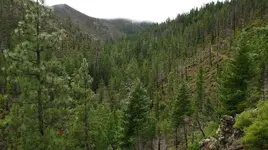
. 1965-
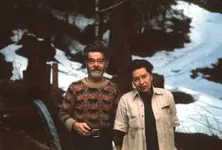
.
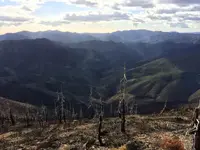
. 1968-
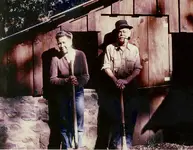
.
Trail from Canyon Creek to Little Chetco River
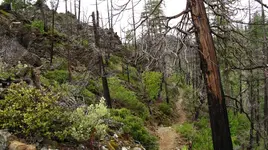
.
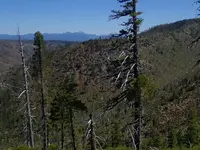
 ?
? 

 . 1965-
. 1965-
 . 1968-
. 1968-
 .
. 
